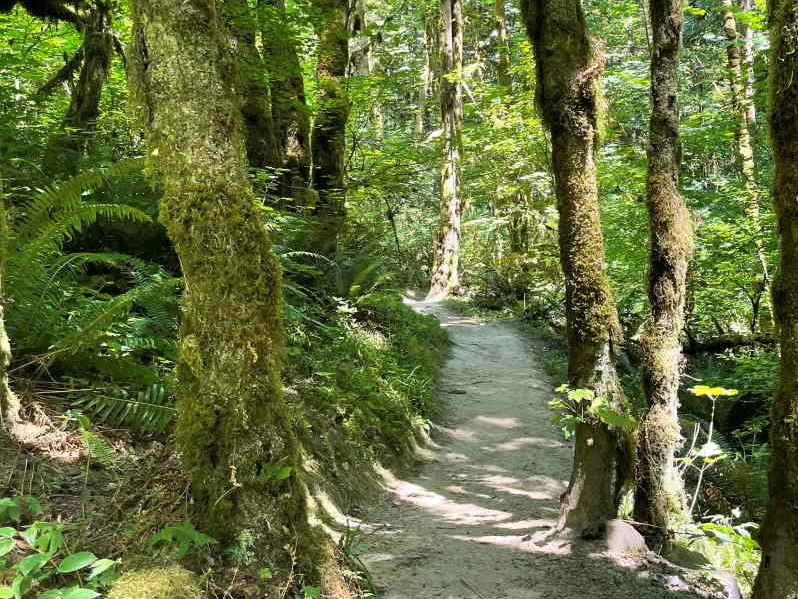“There are other trails I was responsible for putting in, but the Wildwood is the more significant one. It gives me warm fuzzies.” -Fred Nilsen
How Does a Trail Come to Be?
Do you ever think about how some things come to be? You might have some idea about, say, the history of a place like Forest Park, but have you ever thought about how a trail comes to be?
The Wildwood Trail is one of the most famous features of Forest Park, to the point where the blue diamonds on the trees that mark the trail have become iconic. At over 30 miles of trail that connect two ends of the park, it’s no surprise that it’s become such a beloved fixture of Forest Park. But have you ever wondered about the history of the trail?
Talking with Fred Nilsen, Self-Described “Glorified Gardener”
I got the chance to talk to Fred Nilsen, who used to manage Forest Park, Hoyt Arboretum, and other natural resource areas for the City of Portland Bureau of Parks and Recreation from 1986 to 2008. During this time he oversaw the creation of most of the Wildwood Trail.
Nilsen told me he got the job because he knew the scientific names of some local plants. He describes himself as a “glorified gardener” who worked his way up until he was managing parks for the city. Originally he applied for a job managing Hoyt Arboretum, with Forest Park added on as part of the role’s responsibilities.
One of the first things that struck me talking to Nilsen was how similar attitudes towards the park were back when he was working on the trails. He said, “Forest Park was always an attraction because it was an escape.” People have always loved to just get into Forest Park and get lost in nature for a little while.
The Wildwood Trail Experiment
I asked Nilsen about how the trail was created. “Created is a difficult thing to wrap your head around because we don’t have a lot of documentation,” he said. I also asked Nilsen where the name “Wildwood” came from, and he told me that fact was possibly already lost to time, as most of the people who would know the answer have already passed away.
Before Nilsen started working on it, the Wildwood Trail was started between Firelanes 2 and 3. His predecessor, Jim Brade, had started the Wildwood after moving another trail. The first segment of the trail was originally built by a bulldozer. Nilsen says that if you look at the intersection of the Wildwood trail and Fire Lane 2 you might notice that it’s especially wide for a stretch; well, that’s the work of the bulldozer.
Nilsen’s team was “let off their leash” so to speak. They were given a lot of freedom to figure out how they were going to build this trail connecting the two ends of Forest Park. In Nilsen’s words, “It was wild and wooly, no one was there, no one asked questions, and you could do whatever you wanted [to do]. I was having fun.” A homemade measuring wheel made by a volunteer was used to measure the trail while the original trail mile markers were painted and etched in plywood. Truly it sounds like a home DIY project in many ways, but still something undertaken with great care and a lot of pride in the end result. It was an intensive project at that, one that required not just Nilsen’s team but a number of volunteers to help do a massive amount of brushing, flagging, and trail cutting to make the dream of a trail extending 30+ miles through Forest Park into a reality.
A True Community Effort
However, that’s not to say the project wasn’t met with any roadblocks. Regulations and restrictions, while of great importance to protecting the environment, slowed the construction of the trail. Conservation zonings to protect Forest Park’s waterways and natural resources, while important to conservation, presented a hurdle to continuing the Wildwood for a time. However, between the Friends of Forest Park and the city, the proper permitting was worked out to continue the trail.
In addition, late into the process, it was realized that around 80 acres of the park near Newberry road weren’t within the city, but instead controlled by Multnomah County. As a result, this meant additional permitting was required in order to finish the trail, and it wouldn’t be finished before the 50th anniversary of the park in 1998. From Nilsen, “However, the Friends of Forest Park stepped up to bat and spent around $10,000 to obtain the permits. It really was a community effort to get this trail finished.” The trail was then quickly finished in 1999.
Conclusion
I’m glad I had the chance to connect with Mr. Nilsen because it gave me a deeper appreciation for how something like a trail comes to be. For the Wildwood, it was truly a labor of love by people who cared deeply about the outdoors. I’m not sure how often we really think about the people behind things like trails.
I want to conclude with some words from Fred Nilsen, as I think it’s a good message for all of us to remember to really appreciate Forest Park and take advantage of this natural gem. While Forest Park isn’t yet easily accessible to all, I think we should never forget how beneficial it is to our community. We should continue to endeavor to introduce more people to this magical place.
“I think over time we’ve just had people discovering this resource [Forest Park]. Forest Park benefits everybody, and I don’t think people understood that before. Just think how healthy this is for the entire community.” -Fred Nilsen

